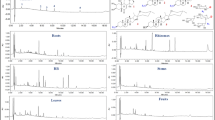Abstract
The genus Claviceps (Clavicipitaceae) is famous for producing ergot alkaloids (EAs) in sclerotia. EAs can cause ergotism, resulting in convulsions and necrosis when ingested, making these compounds a serious concern for food safety. Agroclavine (2), a typical Clavine-type EA, is a causative agent of ergotism and is listed as a compound to be monitored by the European Food Safety Authority. Clavine-type EAs are known to cause cytotoxicity, but the mechanism has not been elucidated. We performed annexin V and PI double-staining followed by flow cytometric analysis to detect apoptosis in HepG2 and PANC-1 cells after exposure to Clavine-type EAs. Clavine-type EAs reduced cell viability and induced apoptosis in both cell lines. We then performed LC–MS analysis of EAs from 41 sclerotia samples of Claviceps collected in Japan. 24 out of 41 sclerotia extracts include peptide-type EAs (ergosine/inine: 4/4′, ergotamine: 5, ergocornine/inine: 6/6′, α-ergocryptine/inine: 8/8′, and ergocristine/inine: 9/9′) and 19 sclerotia extracts among 24 sclerotia detected peptide type EAs include Clavine-type EAs (pyroclavine: 1, agroclavine: 2, festuclavine: 3) by LC–MS. We then performed a metabolomic analysis of the EAs in the sclerotia using principal component analysis (PCA). The PCA score plots calculated for EAs suggested the existence of four groups with different EA production patterns. One of the groups was formed by the contribution of Clavine-type EAs. These results suggest that Clavine-type EAs are a family of compounds requiring attention in food safety and livestock production in Japan.





Similar content being viewed by others
Data availability
The data that support the findings of this study are available from the corresponding authors upon reasonable request.
References
Flieger M, Wurst M, Shelby R (1997) Ergot alkaloids - sources, structures and analytical methods. Folia Microbiol (Praha) 42:3–30
Lee MR (2009) The history of ergot of rye (Claviceps purpurea) II: 1900–1940. J R Coll Physicians Edinburgh 39:365–369
Lee MR (2009) The history of ergot of rye (Claviceps purpurea) I: from antiquity to 1900. J R Coll Physicians Edinb 39:179–184
Buchta M, Cvak L (1999) Ergot alkaloids and other metabolites of the genus Claviceps. Ergot. CRC Press, Florida, pp 188–216
Krishnamachari KA, Bhat RV (1976) Poisoning by ergoty bajra (pearl millet) in man. Indian J Med Res 64:1624–1628
Belser-Ehrlich S, Harper A, Hussey J, Hallock R (2013) Human and cattle ergotism since 1900. Toxicol Ind Health 70:307–316
Urga K, Asfaw D, Yeshi WM, Agata N, Abebe B, Wubalem Z (2002) Laboratory studies on the outbreak of Gangrenous ergotism associated with consumption of contaminated barley in Arsi, Ethiopia. Ethiop J Heal Dev 16:317–323
European food safety Authority (2012) Scientific Opinion on ergot alkaloids in food and feed. EFSA J 10:2798
Takemoto J (1944) [Investigation of “alkaloid” content in domestic and foreign wild ergot (Report 1) qualitative test.] Naigai yasei bakkaku no “alkaloid” ganyu tyousa (dai 1 hou) teisei shiken (in Japanese). Yakugaku Zasshi 64:225–228
Takemoto J (1944) [Investigation of “alkaloid” content in domestic and foreign wild ergot (Report 2) quantitative test.] Naigai yasei bakkaku no “alkaloid” ganyu tyousa (dai 2 hou) teiryou shiken (in Japanese). Yakugaku Zasshi 64:228–231
Tanaka K, Sugawa T (1952) Studies on ergot alkaloids by paper partition chromatography I. Yakugaku Zasshi 72:616–620
Tanaka K, Sugawa T (1952) Studies on ergot alkaloids by paper partition chromatography II. Yakugaku Zasshi 72:620–623
Doi Y, Wakana D, Takeda H, Tanaka E, Hosoe T (2022) Production of ergot alkaloids by the Japanese isolate Claviceps purpurea var. agropyri on rice medium. Adv Microbiol 12:254–269
Mulac D, Lepski S, Ebert F, Schwerdtle T, Humpf HU (2013) Cytotoxicity and fluorescence visualization of ergot alkaloids in human cell lines. J Agric Food Chem 61:462–471
Mrusek M, Seo EJ, Greten HJ, Simon M, Efferth T (2015) Identification of cellular and molecular factors determining the response of cancer cells to six ergot alkaloids. Invest New Drugs 33:32–44
Hothorn T, Bretz F, Westfall P (2008) Simultaneous inference in general parametric models. Biometrical J 50:346–363
Píchová K, Pažoutová S, Kostovčík M, Chudíčková M, Stodůlková E, Novák P, Flieger M, Linde E, Kolařík M (2018) Evolutionary history of ergot with a new infrageneric classification (Hypocreales: Clavicipitaceae: Claviceps). Mol Phylogenet Evol 123:73–87
Haarmann T, Lorenz N, Tudzynski P (2008) Use of a nonhomologous end joining deficient strain (Δku70) of the ergot fungus Claviceps purpurea for identification of a nonribosomal peptide synthetase gene involved in ergotamine biosynthesis. Fungal Genet Biol 45:35–44
Lorenz N, Haarmann T, Pažoutová S, Jung M, Tudzynski P (2009) The ergot alkaloid gene cluster : functional analyses and evolutionary aspects. Phytochemistry 70:1822–1832
Hicks C, Witte TE, Sproule A, Lee T, Shoukouhi P, Popovic Z, Menzies JG, Boddy CN, Liu M, Overy DP (2021) Evolution of the ergot alkaloid biosynthetic gene cluster results in divergent mycotoxin profiles in Claviceps purpurea sclerotia. Toxins (Basel) 13:861
Acknowledgements
This work was supported by JSPS KAKENHI Grant Number 16K07238.
Author information
Authors and Affiliations
Corresponding author
Ethics declarations
Conflict of interest
The authors declare no conflict of interest. The funders had no role in the design of the research.
Additional information
Publisher's Note
Springer Nature remains neutral with regard to jurisdictional claims in published maps and institutional affiliations.
Rights and permissions
Springer Nature or its licensor (e.g. a society or other partner) holds exclusive rights to this article under a publishing agreement with the author(s) or other rightsholder(s); author self-archiving of the accepted manuscript version of this article is solely governed by the terms of such publishing agreement and applicable law.
About this article
Cite this article
Doi, Y., Wakana, D., Kitaoka, S. et al. Ergot alkaloids in sclerotia collected in Japan: synthetic profiles and induction of apoptosis by Clavine-type compounds. J Nat Med 77, 306–314 (2023). https://doi.org/10.1007/s11418-022-01673-8
Received:
Accepted:
Published:
Issue Date:
DOI: https://doi.org/10.1007/s11418-022-01673-8




